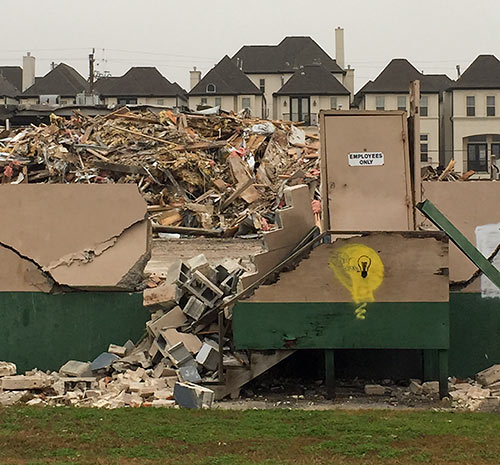
Sure, we all know the future of East Downtown is townhomes, and that the industrial structures that once dominated that landscape are on their way out. But have you seen a set of photos that better illustrates the transformation than this gallery of views taken by reader Jeff Peoples this morning? It shows the demolition of the former International Mailing Systems warehouse building at 815 Live Oak St. Not much more need for them to be close to downtown.
You can see the townhomes marching from the background of the above photo, smashing everything in their way.
***
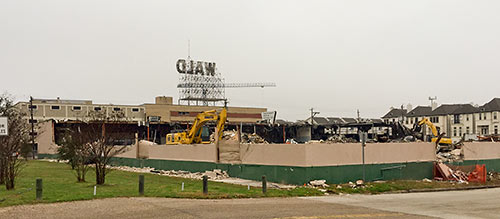
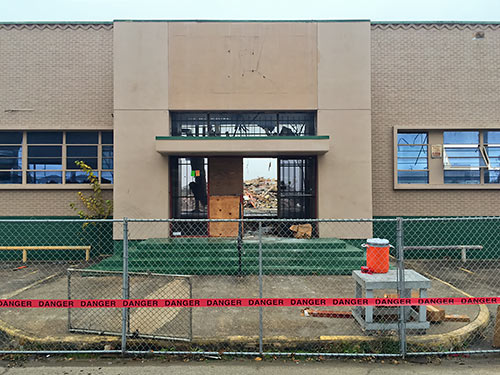
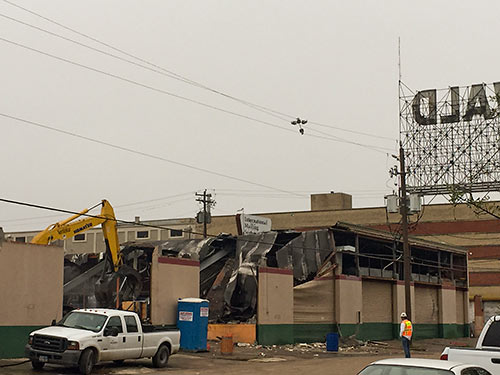
InTown Homes, part of a family of companies controlled by developer Frank Liu, bought the 61,250-sq.-ft. building last June. When it’s demolished, there’ll be 1.43 acres of land along the Columbia Tap Trail, 3 blocks east of BBVA Compass Stadium, ready for more InTown EaDo townhomes. Listen carefully, and you can hear them munching on the rubble.
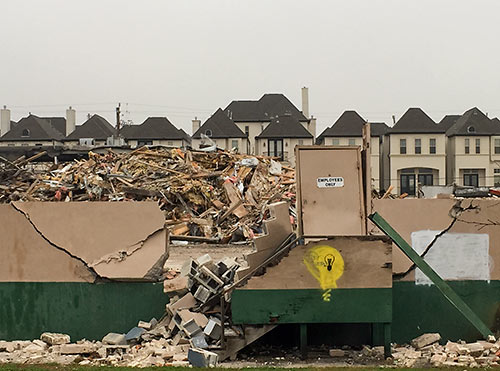
Photos: Jeff Peoples


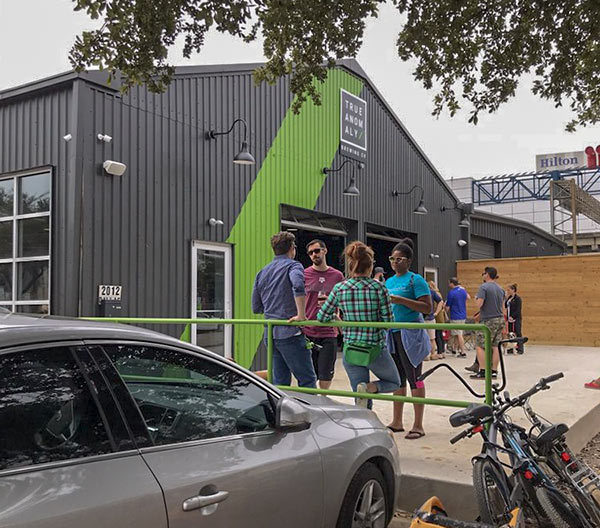
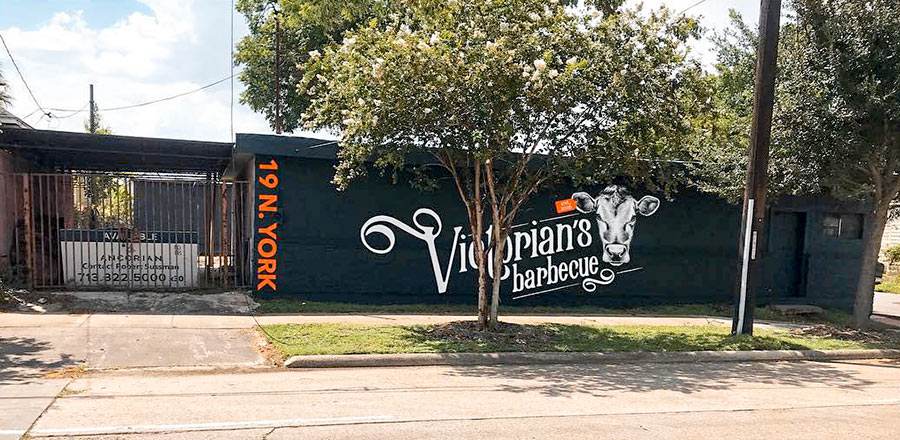

“Villas at WALD”
I hope that cool old Wald sign stays – I’d really miss it if it goes.
Would be an interesting take if they did include the WALD signage but it would probably block the view of downtown which is a major pull to live on the east end in that area.
More stucco crap that will fall into foreclosure…
Mr.Clean19 — you mean the only pull to leave in EaDo
*live
Oh, I hope the WALD sign is spared.
Did I stutter?
https://www.google.com/search?q=pulp+fiction+samuel+l+jackson&biw=1350&bih=1021&tbm=isch&imgil=r4HVnqLyw3UamM%253A%253ByEl2tDGL-M92uM%253Bhttp%25253A%25252F%25252Ffoodtest.wikia.com%25252Fwiki%25252FFile%25253ASamuel_L._Jackson_Pulp_fiction_2.png&source=iu&pf=m&fir=r4HVnqLyw3UamM%253A%252CyEl2tDGL-M92uM%252C_&usg=__qzQzCzI_nWqcVX2G9GSsoo6wJrE%3D&dpr=1&ved=0CJYBEMo3&ei=DizBVLiqOIeegwTll4HoDQ#imgdii=_&imgrc=r4HVnqLyw3UamM%253A%3ByEl2tDGL-M92uM%3Bhttp%253A%252F%252Fimg2.wikia.nocookie.net%252F__cb20120815223028%252Ffoodtest%252Fimages%252F8%252F8c%252FSamuel_L._Jackson_Pulp_fiction_2.png%3Bhttp%253A%252F%252Ffoodtest.wikia.com%252Fwiki%252FFile%253ASamuel_L._Jackson_Pulp_fiction_2.png%3B405%3B270
Wow, when will a grocery store and a school get built?
So – when a developer proposes something like this does the city actually study it to ensure that there is adequate infrastructure – roads, sewers, drainage, garbage collection, power supply, etc to accommodate this increase in population before they permit it? I’ve always been curious… It seems like no based on Rice Military and even Montrose/Montrose adjacent to some extent. Can someone here who knows, or pretends on the internet to know, how these things get approved weigh in?
TIRZ 15 is supposed to start redoing roads, utility and sewer lines soon with phase 1 to complete by next year.
anon, you should take a drive around here sometime. the streets are empty. I mean, like just me and a few other cars on a normal day.
.
I’ll grant you, if you are out on a Friday or a Saturday trying to find somewhere to park to eat at Huynh, that’s not likely to happen. But there’s a concert venue right across the street, and about 5 bars all packed into a small area.
.
As far as the electricity goes, it’s an interesting question. replacing industrial buildings, which probably had machines in them that required a lot of electricity in their day to operate, vs houses which will be built to energy efficient codes, do the houses have a higher energy requirement than the industrial site did?
Eastwood, which is about 2 minutes down McKinney street from these townhomes, is already getting new gas mains installed as we speak and got repaved streets a couple years ago. And they have been improving the drains along Leeland St. near Lockwood. Not to mention new sidewalks. So, my guess is that they ARE paying attention to the area, to some degree…
@Anon
. “when a developer proposes something like this does the city actually study it to ensure that there is
. adequate infrastructure – roads, sewers, drainage, garbage collection, power supply, etc to
. accommodate this increase in population before they permit it?”
.
.
I’ll field an engineering answer for that one. Yes, the city requires that large infill projects verify utility capacity.
If it includes more than 500′ of streets, the water lines will be tested to verify adequate fire flow; if the existing system can’t supply that, the developer must pay for upsizing the main.
.
If it involves more than an acre of development, they require sanitary calculations showing that the existing sewer lines just downstream of the project are adequately sized based on modern usage characteristics (# dwelling units * average daily flow * peaking factor). Very frequently, these large infill developers pay the city to replace a few blocks of 50+ year old 4″ vitrified clay pipes with modern 6″ or 8″ PVC or ductile iron pipe.
.
Developments over 1 acre have to verify that they won’t flood themselves or any one else. The City always wants to see 2 things: on site detention added and also that the downstream receiving channel or storm sewer has adequate capacity – trouble is that second part never happens. So, the developer’s engineer jumps through some very tiny hoops and makes some logic-stretched arguments, and the city just allows it because if they didn’t their tax base would stagnate. Every channel and storm sewer in Houston built before about 1990 is undersized, and we all know it. But we keep connecting new stuff to the old stuff because life goes on.
.
Roads & garbage collection are a whole ‘nother story. Garbage collection depends on road capacity, which is a very subjective subject. Usually the City wants to see trip generation, queue length, and parking space requirements. Those reports are based on a large number of assumed factors, which usually lets the developer just assume favorable rates and the City can’t call them out on it. The issue you’re hinting at is really that the additional traffic will decrease the road’s “level of service”, which the City only looks at in larger regional mobility studies.
.
Power supply isn’t done by the City but it’s so easily solved it’s NDB. Standard service lines in the area are 7200v, which can serve 1,000 homes or so. No single development’s going to make a dent in it. At most, it will up the peak current in the wire by 500amps or so, which will cause the wire to get about 5 degrees hotter in the summer during peak demand.
Ornlu, thanks for the info!
So Houston’s growth isn’t completely developer/cash driven. There are checks and req’s,
Ornlu, I’m wondering if the city charges developers for the loss of commerce that their needed utility projects cause (traffic congestion, loss to surrounding businesses, etc.). Is it built in to what is charged for those services? Not being an ass, just curious. You seem to be “in the know” as they say. Thanks!